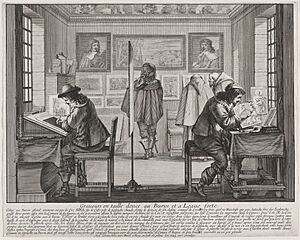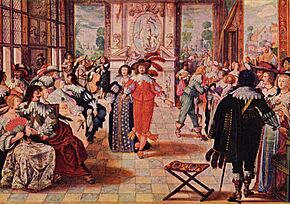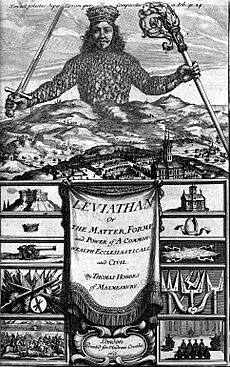Abraham Bosse facts for kids
Quick facts for kids
Abraham Bosse
|
|
|---|---|
 |
|
| Born | c. 1604 |
| Died | 14 February 1676 (aged 71–72) |
| Occupation | printmaker |
Abraham Bosse (around 1604 – February 14, 1676) was a famous French artist. He was mainly known for making prints using a technique called etching. He also used watercolours sometimes.
Contents
Life Story of Abraham Bosse
Abraham Bosse was born in Tours, France. His parents were Huguenots, which means they were French Protestants. His father was a tailor who had moved from Germany. Because of his father's job, Bosse always paid close attention to clothes in his artwork. He showed them in great detail.
In 1632, he married Catherine Sarrabat in Tours. He remained a Huguenot his whole life. He died before the Revocation of the Edict of Nantes, which was a time when Protestants faced difficulties in France. Even so, he was happy to create religious art for Catholic people.
His Artistic Work
Abraham Bosse created about 1600 etchings. These were prints made by scratching designs onto metal plates. His artworks showed many different things. He drew scenes from everyday life, religious stories, and even fashion. He also depicted technology and science.
Most of his prints were used as pictures in books. But many were also sold on their own.
Bosse's Unique Style
His art style was influenced by Dutch and Flemish art. But he added a strong French touch to it. Many of his pictures give us a lot of information. They show what life was like for middle and upper-class people back then. However, we need to be careful when using them as historical proof.
Bosse was very original in his art. He often showed grand rooms with small, everyday objects. This style was very new and influenced many French artists. It even influenced artists in other countries. For example, William Hogarth's famous engravings were partly a playful copy of Bosse's style. Many people see his images more as illustrations than as fine art.
Around 1620, Bosse started learning art in Paris. He trained with Melchior Tavernier, an engraver and important publisher from Antwerp. Bosse made his first etchings in 1622. These early works were inspired by another artist, Jacques Bellange.
Learning from Jacques Callot
Around 1630, Bosse met Jacques Callot in Paris. Callot was a very skilled etcher. Bosse became a follower of Callot. He helped make Callot's new etching techniques popular. He wrote a famous book about it called Traité des manières de graver en taille-douce. This means 'Treatise on Line Engraving'. It was published in 1645 and translated into many languages.
Callot made very detailed small images. Bosse took Callot's ideas and used them to create larger prints. He also explored more types of subjects.
Etching vs. Engraving
Unlike Callot, Bosse wanted his etchings to look like engravings. Engravings are made by cutting lines directly into a metal plate. Etching uses acid to create the lines. Bosse was willing to make his etched lines less free to achieve this look. But he still used the speed of etching.
Like most etchers, he often used both etching and engraving on the same plate. But he never made prints that were purely engravings.
Important Artworks
Etchings and Prints
- Le jardin de la Noblesse françoise (1629) — Shows French fashion.
- Les Cris de Paris (around 1630) — Shows street sellers in Paris.
- Le mariage à la ville, le mariage à la campagne (1633) — Compares city and country weddings.
- Les métiers (1635?) — Shows different jobs and trades.
- Pictures for L'Ariane (1639) — Illustrations for a book.
- Pictures for Le Trésor des merveilles de la Maison Royale de Fontainebleau (1642) — Shows wonders of the Royal Palace of Fontainebleau.
- De la manière de graver à l'eaux-forte et au burin (1645) — His famous book on how to etch and engrave.
- Traité des manières de graver en taille douce sur l'airin par le moyen des eaux-fortes... (1645) — Another name for his "Manual of Etching."
- Manière universelle de M. des Argues pour pratiquer la perspective par petit-pied comme le géométral... (1648) — A guide on how to draw perspective.
- The famous front page for Leviathan (1651) by Thomas Hobbes. Hobbes himself helped with this design.
- Pictures for La Pucelle ou la France délivrée (1656) — Illustrations for a book.
- Des ordres des colonnes (1664) — About architecture, specifically columns.
- Traité des pratiques géométrales et de perspective (1665) — A book about geometry and perspective.
Later Collections of His Work
- Die Kunst, in Kupfer zu stechen, Ilmer, Osnabrück 1975 (A reprint of an edition from Nuremberg 1765).
- Radier-Büchlein. Handelt von der Etzkunst, nemlich wie man mit Scheidwasser in Kupfer etzen, das Wasser und wie auch den harten und weichen Etzgrund machen solle, Moos, München 1977, ISBN: 3-7879-0088-8 (A reprint of an edition from Nuremberg 1689).
Gallery
-
The Shoemakers, etching (National Gallery of Art)
-
The Valet, engraving in black on laid paper, 29 x 20.4 cm (11 7/16 x 8 1/16 in.), (National Gallery of Art)
-
Adolescence, 1636, engraving and etching (National Gallery of Art)
-
Manhood, 1636, engraving and etching (National Gallery of Art)
-
Engravers, 1642, etching (National Gallery of Art)
-
Childhood, 1636, engraving and etching (National Gallery of Art)
-
Death, 1636, engraving and etching (National Gallery of Art)
-
Odoratus, L'Ordorat, engraving in black on laid paper, 24 x 32 cm (9 7/16 x 12 5/8 in.) (National Gallery of Art)
-
Louis XIII as Hercules, engraving and etching (National Gallery of Art)
-
Michel Larcher, 1647, engraving (National Gallery of Art)
-
Gentry Visiting a Prison, engraving with etching, 25.4 x 32.2 cm (10 x 12 11/16 in.) (National Gallery of Art)
-
The Wise Virgins at Prayer, etching on laid paper, plate: 26 x 33 cm (10 1/4 x 13 in.) (National Gallery of Art)
-
The Foolish Virgins Sleeping, etching on laid paper, plate: 25.4 x 32 cm (10 x 12 5/8 in.) sheet: 29.2 x 36.2 cm (11 1/2 x 14 1/4 in.) (National Gallery of Art)
-
The Prodigal Son as a Swineherd, engraving (National Gallery of Art)
-
Le Noble Peintre, 1642, etching on laid paper, plate: 9 7/8 x 12 11/16 in. (25.1 x 32.2 cm), sheet: 26.4 x 33.3 cm (10 3/8 x 13 1/8 in.) (National Gallery of Art)
-
Frontispiece for Callot's "The Penitents", etching and engraving (National Gallery of Art)
-
The Wise Virgins before the Fire, etching on laid paper, plate: 26 x 33 cm (10 1/4 x 13 in.) (National Gallery of Art)






















